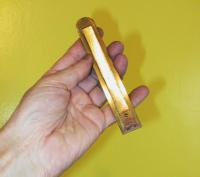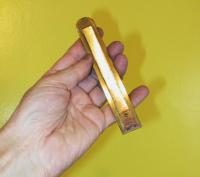-
Posts
557 -
Joined
-
Last visited
Posts posted by Mike Pierceall
-
-
The range is a full 2 octaves lower than C/G so yes, the lowest note is C 3 octaves below middle C. As you say the lowest note in this recording is the G above that. I'll make sure to use the super low C if I record anything else on the bass. The bottom note is so low that you can actually feel it in your arm before it sounds, it's glorious!
Wow! This is the first concertina I've heard of that actually goes that low.
I look forward to hearing it. Meanwhile, I'll check that my home insurance covers earthquake damage.

I want one! I want one! But I'm sure if Jim has never heard of one prior, there's no chance of that. That largest reed I ever had to move air through was a pedal bass in a reed organ I restored, but I had the advantage of being able to use my legs instead of my spindly arms.

-
enjoyable as ever Michael. the description said a 61 key tenor treble. I usually think of 56 buttons for a TT. What extra range do you have?
- John.
Thank you, John. The additional notes bring the instrument up to D# in the 7th position. The lowest note is, as typical for a TT, C below middle C. It is unusual in that most extended TT's I've seen are 64-key instruments.
-
Mike:
Nice playing as always.
Did you 'sweeten' the tone with a bit of audio post-processing or is that really how that New Model sounds?
Really nice round sound.
I also did not hear any Lachenal action clacking. What sort of action is this?
Don.
Thank you, Don. The sound is as-recorded. No post processing. The action is the standard Lachenal hook action. This is the second set of bellows I've made for this instrument. The first set used a heavier-weight card stock that was not entirely to my liking. I used a thinner and harder card stock for this set, which gives the instrument a brighter tone.
-
This is an instrument I've been restoring on and off for the past couple of years. I installed a new set of bellows today. This is an impromptu video here:
-
The ends seem to have been repaired with PVA glue, which would make proper repair with hide glue problematic as the two don't mix. As long as the previous repairs are holding, I would leave well enough alone as undoing PVA joints would likely fracture the ends into bits and pieces. I have successfully used very thin cotton twill cloth soaked in liquid hide glue to reinforce open fractures from the underside. If you attempt to compress the cracks back together, you may well open up other cracks.
-
I really enjoyed that and just like many of your other videos it left me with a great sense of peace.
Is your arrangement fully worked out or are you improvising the jazz runs?
Thanks, Don. I write everything out during the arrangement process... including the improvisations

-
My offering this year for the holiday season here:
-
On my Wheatstone 5A here:
-
Thanks as always, Wolf. Mike
-
A version for English concertina here:
-
Mike, this is a truly beautiful transformation of a piece that probably many of us (like myself) are familiar with and affected by. The diminished chords sound great, the rubato keeps the whole thing interesting, and the fragile melody comes, mostly, through.
However, if you don't mind me, there's still something distracting with the recording, prompting me to give it a looped listen to really discover the beauty in it. I guess it comes from some harsh moments which may be forced by lack of sufficient air supply and subsequent bellows reversal - I'm not sure here.
Don't get me wrong: I'm not advocating for everything to be kept completely calm and tender - but the take may deserve slightly more balance re timing, volume, attack. I'm aware of how hard these final improvements are achieved but hope you can use a hint, combined with appreciation.
So good that you're keeping up the performing business here (it's all about the music, isn't it?), which I'm inclined to rejoin in the near future myself as well (and I simply love your reed organ videos too!).
Best wishes - Wolf
HI, Wolf. Feedback appreciated. I went back and forth between my Aeola, which has a mellower tone but is less responsive and the 5A, which has a hair-trigger response, but can be difficult to throttle back. In the end I used the 5A because the bellows I made for it can supply the air to carry out those long phrases. The arrangement itself went through perhaps 25 drafts. I'm still making changes! It might be fascinating (or not) to make a video that gives some insight into the arranging process. At any rate, I'll continue to fine tune the execution, and thanks for your observations.
-
On my Wheatstone 5A English treble here:
-
It's a lullaby, but the not the one that is usually associated with Brahms. Just an excerpt, played on my 1909 treble Aeola. Here:
-
A nice hymn arrangement of a piece by A.L. Butler, played on my 1909 Aeola here:
-
I recall an interview of Sir James Galway, who still practices scales, saying, and I paraphrase, that it's all about finding the right note at the right time.
-
This started out as an arrangement I put together for a friend with a soprano Ukulele, but I decided to record it on my Aeola English. Here:
-
Some Jazz on the Lachenal New Model TT I restored recently. It's here:
The larger volume of the TT produces a warmer tone than that of a standard treble. In fact, most of this piece was played in the treble range.
-
Is this tale of Edeophones rolling off tables a myth, a theoretical possibility or a reality?
I never had any problems when I had an Edeophone and I've never met anyone who knew of an actual occasion when it happened.
Does anyone know of an Edeophone that really rolled?
Not of their own accord, more than likely knocked off an edge, or set into motion.
-
Replacement bellows that you can install yourself are readily available and not terribly expensive. It sounds like you have the skill to do the installation even if you choose not to build a set from scratch. Of course, I'm all for experimentation, and sometimes innovation comes from the need to improvise.
-
Contact Randy Stein (search members). He studied with both Boris and Serge M.
Boris did not do his own repairing. He mostly used Alex's Accordion repair shop on 48th Street although also used Accordion-o-rama which at the time had a Wheatstone-trained repair person. I recall reading that Alex finally retired at the age of 90!
Thank you, David and Richard.
-
I was wondering, did Boris Matusewitch service the instruments used by his students? I restored one of these instruments and was delighted at the quality of the reeds which had previously been re-tuned to modern pitch.
-
Antique, entry-level Lachenals and the like can sometimes be found at reasonable prices, though I haven't seen any lately. It can be a gamble. If the reeds are badly corroded or were improperly tuned in the past, the instrument can only be salvaged for parts. I suggest you post a wanted ad in the Buy and Sell Forum and deal with someone in the know. Best of luck.
-
Marcus Music has given me the dimensions of their anglo concertina (to get in July) and I will be in Morocco this weekend to request a leather worker to make a case for it. Looking at many great designs & great input from all, I added ... 2cm+ space on all sides (for padding & shrinkage), can be carried by hand or shoulder, sits on its side (not ends), opens from ends, etc., etc.
DESIGN FLAWS? Ugly?
 ... before I try to get a bag like this made? Any ideas greatly appreciated.
... before I try to get a bag like this made? Any ideas greatly appreciated.Looks good to me although I prefer a traditional box shape with a top lid so that I can remove the concertina using both hands.
-
Why do low reeds have wider vents than high ones? What would happen if one were to make a set of reeds that were all the same width?
Related question: if one were to proportionally scale all the reeds wider or narrower (not changing the lengths or profiling), what effects would that have on the instrument?
This is a 32' reed from one of my harmonium restorations. It speaks as quickly as the smallest reed in the organ. Large reeds need to be sturdy due to the force required to lift them. I once restored an organ where 7 of the sub-bass reeds were broken off at the heel and the tongues had been sucked into the air reservoir.




The Folks Who Live On The Hill
in Concertina Videos & Music
Posted
One last video for the year, played on this wonderful Wheatstone 5A from 1918 that I restored. To all my friends and followers in the concertina world, have a happy New Year! here: